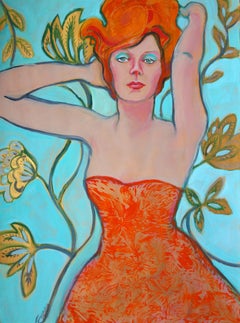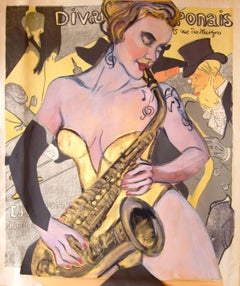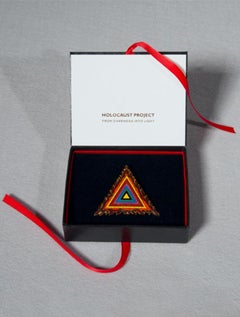Freda Alschuler Art
to
3
3
2
1
Overall Height
to
Overall Width
to
1
1
1
1
1
3
3
6,910
3,230
2,514
1,217
2
1
1
1
Artist: Freda Alschuler
Dream, Mixed Media on Watercolor Paper
By Freda Alschuler
Located in Yardley, PA
decorative art Italian influence :: Mixed Media :: Italian & Tuscan :: This piece comes with an official certificate of authenticity signed by the artist :: Ready to Hang: No :: Sig...
Category
2010s Other Art Style Freda Alschuler Art
Materials
Mixed Media
Summer, Painting, Gouache on Watercolor Paper
By Freda Alschuler
Located in Yardley, PA
beautiful woman, hand linoleum printed dress :: Painting :: Classical :: This piece comes with an official certificate of authenticity signed by the artist :: Ready to Hang: No :: S...
Category
2010s Other Art Style Freda Alschuler Art
Materials
Gouache
Sexaphone, Mixed Media on Watercolor Paper
By Freda Alschuler
Located in Yardley, PA
Painted figure with collage print of Toulouse Lautrec :: Mixed Media :: Art Deco/Art Nouveau :: This piece comes with an official certificate of au...
Category
2010s Art Deco Freda Alschuler Art
Materials
Mixed Media
Related Items
Holocaust Remembrance Logo Pin and Pendant
By Judy Chicago
Located in New York, NY
Judy Chicago
Logo Pin and Pendant, 1993
Enameled pin with pendant loop in original presentation box
2 1/2 × 2 1/2 × 1/5 inches
Judy Chicago's incised name and date on the verso
Comes in original presentation gift box
Poignant enameled Holocaust Project Logo pin & pendant based on the logo designed by Judy Chicago for the Holocaust Project: From Darkness into Light
More about pioneering artist Judy Chicago
Judy Chicago (born Judith Sylvia Cohen; July 20, 1939) is an American feminist artist, art educator, and writer known for her large collaborative art installation pieces about birth and creation images, which examine the role of women in history and culture. During the 1970s, Chicago founded the first feminist art program in the United States at California State University, Fresno (formerly Fresno State College) which acted as a catalyst for feminist art and art education during the 1970s. Her inclusion in hundreds of publications in various areas of the world showcases her influence in the worldwide art community. Additionally, many of her books have been published in other countries, making her work more accessible to international readers. Chicago's work incorporates a variety of artistic skills, such as needlework, counterbalanced with skills such as welding and pyrotechnics. Chicago's most well known work is The Dinner Party, which is permanently installed in the Elizabeth A. Sackler Center for Feminist Art at the Brooklyn Museum. The Dinner Party celebrates the accomplishments of women throughout history and is widely regarded as the first epic feminist artwork. Other notable art projects by Chicago include International Honor Quilt, Birth Project, Powerplay, and The Holocaust Project. She is represented by Jessica Silverman...
Category
1990s Abstract Geometric Freda Alschuler Art
Materials
Metal, Enamel
The Abduction of the Sabine Women , a Renaissance drawing by Biagio Pupini
Located in PARIS, FR
This vigorous drawing has long been attributed to Polidoro da Caravaggio: The Abduction of the Sabine Women is one of the scenes that Polidoro depicted between 1525 and 1527 on the façade of the Milesi Palazzo in Rome. However, the proximity to another drawing inspired by this same façade, kept at the Ecole des Beaux-Arts, and to other drawings inspired by Polidoro kept at the Musée du Louvre, leads us to propose an attribution to Biagio Pupini, a Bolognese artist whose life remains barely known, despite the abundant number of drawings attributed to him.
1. Biagio Pupini, a Bolognese artist in the light of the Roman Renaissance
The early life of Biagio Pupini, an important figure of the first half of the Cinquecento in Bologna - Vasari mentions him several times - is still poorly known. Neither his date of birth (probably around 1490-1495) nor his training are known. He is said to have been a pupil of Francesco Francia (1450 - 1517) and his name appears for the first time in 1511 in a contract with the painter Bagnacavallo (c. 1484 - 1542) for the frescoes of a church in Faenza. He then collaborated with Girolamo da Carpi, at San Michele in Bosco and at the villa of Belriguardo.
He must have gone to Rome for the first time with Bagnacavallo between 1511 and 1519. There he discovered the art of Raphael, with whom he might have worked, and that of Polidoro da Caravaggio. This first visit, and those that followed, were the occasion for an intense study of ancient and modern art, as illustrated by his abundant graphic production.
Polidoro da Caravaggio had a particular influence on the technique adopted by Pupini. Executed on coloured paper, his drawings generally combine pen, brown ink and wash with abundant highlights of white gouache, as in the drawing presented here.
2. The Abduction of the Sabine Women
Our drawing is an adaptation of a fresco painted between 1525 and 1527 by Polidoro da Caravaggio on the façade of the Milesi Palace in Rome. These painted façades were very famous from the moment they were painted and inspired many artists during their stay in Rome. These frescoes are now very deteriorated and difficult to see, as the palace is in a rather narrow street.
The episode of the abduction of the Sabine women (which appears in the centre of the photo above) is a historical theme that goes back to the origins of Rome and is recounted both by Titus Livius (Ab Urbe condita I,13), by Ovid (Fasti III, 199-228) and by Plutarch (II, Romulus 14-19). After killing his twin brother Romus, Romulus populates the city of Rome by opening it up to refugees and brigands and finds himself with an excess of men. Because of their reputation, none of the inhabitants of the neighbouring cities want to give them their daughters in marriage. The Romans then decide to invite their Sabine neighbours to a great feast during which they slaughter the Sabines and kidnap their daughters.
The engraving made by Giovanni Battista Gallestruzzi (1618 - 1677) around 1656-1658 gives us a good understanding of the Polidoro fresco, allowing us to see how Biagio Pupini reworked the scene to extract this dynamic group.
With a remarkable economy of means, Biagio Pupini takes over the left-hand side of the fresco and depicts in a very dense space two main groups, each consisting of a Roman and a Sabine, completed by a group of three soldiers in the background (which seems to differ quite significantly from Polidoro's composition).
The balance of the drawing is based on a very strongly structured composition. The drawing is organised around a median vertical axis, which runs along both the elbow of the kidnapped Sabine on the left and the foot of her captor, and the two main diagonals, reinforced by four secondary diagonals. This diamond-shaped structure creates an extremely dynamic space, in which centripetal movements (the legs of the Sabine on the right, the arm of the soldier on the back at the top right) and centrifugal movements (the arm of the kidnapper on the left and the legs of the Sabine he is carrying away, the arm of the Sabine on the right) oppose each other, giving the drawing the appearance of a whirlpool around a central point of support situated slightly to the left of the navel of the kidnapper on the right.
3. Polidoro da Caravaggio, and the decorations of Roman palaces
Polidoro da Caravaggio was a paradoxical artist who entered Raphael's (1483 - 1520) workshop at a very young age, when he oversaw the Lodges in the Vatican. Most of his Roman work, which was the peak of his career, has disappeared, as he specialised in facade painting, and yet these paintings, which are eminently visible in urban spaces, have influenced generations of artists who copied them abundantly during their visits to Rome.
Polidoro Caldara was born in Caravaggio around 1495-1500 (the birthplace of Michelangelo Merisi, known as Caravaggio, who was born there in 1571), some forty kilometres east of Milan. According to Vasari, he arrived as a mason on the Vatican's construction site and joined Raphael's workshop around 1517 (at the age of eighteen according to Vasari). This integration would have allowed Polidoro to work not only on the frescoes of the Lodges, but also on some of the frescoes of the Chambers, as well as on the flat of Cardinal Bibiena in the Vatican.
After Raphael's death in 1520, Polidoro worked first with Perin del Vaga before joining forces with Maturino of Florence (1490 - 1528), whom he had also known in Raphael's workshop. Together they specialised in the painting of palace façades. They were to produce some forty façades decorated with grisaille paintings imitating antique bas-reliefs.
The Sack of Rome in 1527, during which his friend Maturino was killed, led Polidoro to flee first to Naples (where he had already stayed in 1523), then to Messina. It was while he was preparing his return to the peninsula that he was murdered by one of his assistants, Tonno Calabrese, in 1543.
In his Vite, Vasari celebrated Polidoro as the greatest façade decorator of his time, noting that "there is no flat, palace, garden or villa in Rome that does not contain a work by Polidoro". Polidoro's facade decorations, most of which have disappeared as they were displayed in the open air, constitute the most important lost chapter of Roman art of the Cinquecento. The few surviving drawings of the painter can, however, give an idea of the original appearance of his murals and show that he was an artist of remarkable and highly original genius.
4. The façade of the Milesi Palace
Giovanni Antonio Milesi, who commissioned this palace, located not far from the Tiber, north of Piazza Navona, was a native of the Bergamo area, like Polidoro, with whom he maintained close friendly ties. Executed in the last years before the Sack of Rome, around 1526-1527, the decoration of Palazzo Milesi is considered Polidoro's greatest decorative success.
An engraving by Ernesto Maccari made at the end of the nineteenth century allows us to understand the general balance of this façade, which was still well preserved at the time. The frescoes were not entirely monochrome, but alternated elements in chiaroscuro simulating marble bas-reliefs and those in ochre simulating bronze and gold vases...
Category
16th Century Old Masters Freda Alschuler Art
Materials
Ink, Gouache, Pen
Large Gouache Original Painting Mother & Daughter Sandu Liberman Israeli Judaica
By Sandu Liberman
Located in Surfside, FL
framed 36 X 28 board 30 X 21.75
Sandu Liberman (Romanian-Israeli) was born in Yasi, Romania in 1923. between 1946 and 1953 he took part in the state art shows in Bucharest. in 1952 ...
Category
20th Century Modern Freda Alschuler Art
Materials
Gouache, Paper
Fine Antique French Impressionist Painting View Of A Park with Stone Urn
Located in Cirencester, Gloucestershire
The artist:
Henri Aime Duhem (1860-1941) French *see notes below, signed
Title: The Parkland
Medium:
signed gouache on paper, loosely laid over card, ...
Category
19th Century Impressionist Freda Alschuler Art
Materials
Gouache
"" La dame étonnée "" collage signé
By Jean Cocteau
Located in CANNES, FR
Jean Cocteau ( 1889 - 1963 )
" la Dame étonnée " . Mix Media découpage signed
by Jean Cocteau .
work : 10 x 10 cm
Framed: 27 x 25 cm .
Collage original ,
découpage d'une tasse et d...
Category
1950s Art Deco Freda Alschuler Art
Materials
Mixed Media, Photographic Paper
Joan Miro. Original single piece mixed technique painting
By Joan Miró
Located in CORAL GABLES - MIAMI, FL
Joan Miro. Original single piece mixed technique painting
Joan Miro Ferra
1893-1983
Original Study for “EL GOLAFRE ".NOT SIGNED
1979
Unique.
Gouache, lithotint and crayon on paper
...
Category
Late 20th Century Abstract Freda Alschuler Art
Materials
Paper, Ink, Gouache
H 39.77 in W 28.35 in D 0.4 in
Steel Garden Wall - "Plant Climbing Wall" - modern outdoor ornament - 75×195 cm
By Stefan Traloc
Located in Winterswijk, NL
With this climbing wall you can conjure up an atmospheric ambience in your garden.
The wall is ideal for planting all kinds of climbing plants.
On the one hand, you can easily a privacy screen, e.g. from the neighbouring property, on the other hand, you can use this decorative element beautify your garden.
This art piece will surely be an eye catcher in your yard!
The garden wall is mounted on 2 round steel pins of 18 mm diameter.
These are 1 meter long and are included.
Hammer the round posts into the ground at the correct distance of 50 cm, Push the wall over it and you're done!
We manufacture the garden walls in our own locksmith's shop.
This means that we can also produce special designs, e.g. name plate with house...
Category
21st Century and Contemporary Art Deco Freda Alschuler Art
Materials
Steel
H 76.78 in W 29.53 in D 0.08 in
Untitled, 1965
By Oswaldo Vigas
Located in Palm Beach, FL
Predominantly recognized as a self-taught painter, he also worked in architectural murals, sculptures, ceramics, prints and drawings.
Vigas is one...
Category
1960s Cubist Freda Alschuler Art
Materials
Canvas, Oil, Gouache, Board
1024 Colors - Tufted Carpet by Vorwerk - Unframed
By Gerhard Richter
Located in Winterswijk, NL
Gerhar Richter, in collaboration with Vorwerk, made a special edition titled: 1024 Colors.
The color palette by Richter is brought in with high quality pieces of carpet.
*The images...
Category
20th Century Art Deco Freda Alschuler Art
Materials
Textile, Mixed Media
No Reserve
H 29.53 in W 30.71 in
Abstract Botanical Art Deco Painting Diptych of Nocturnal Flower Fields, Paper
By Natalia Roman
Located in Barcelona, ES
"Nocturnal Flower Fields" is an abstract painting by Spanish artist Natalia Roman. It is a beautiful abstract architectural painting of unique blurry shapes brushstrokes in pastel Ar...
Category
2010s Abstract Impressionist Freda Alschuler Art
Materials
Oil Pastel, Oil, Acrylic, Watercolor, Gouache
Sujoon - Cornflower Portal - Large Lightweight Three-Dimensional Wall Sculpture
By Atticus Adams
Located in Los Angeles, CA
Atticus Adams' organically composed modern metal sculptures embody the transformative power of contemporary art, illustrating the creation of beauty, meaning, and emotional impact from industrial materials. Using mostly aluminum mesh—generally found in screen doors, windows, and filters—he creates contemporary abstract sculptural artworks and installations, which resemble flowers, clouds, and other natural phenomena. Working in metal, Adams effortlessly transforms rigid material into airy, effervescent artworks.
This 48-inch high by 44-inch wide and 4-inch deep metal sculpture is a lightweight form. It is created from aluminum and copper mesh, gesso, acrylic paint, and wire. It has metal rings affixed on the back which allows for easy installation. Atticus works spontaneously, feeling his way toward the objects that take shape in his mind as he shapes them almost entirely by hand. Free local Los Angeles area delivery. Affordable Continental U.S. and worldwide shipping. A certificate of authenticity issued by the art gallery is included.
Atticus grew up in West Virginia, steeped in traditional folk art. Several members of his family are self-taught artists, deeply involved in such crafts as wood carving and quilting. His formal art training includes stints at Yale, Rhode Island School of Design, and Harvard’s School of Architecture. Atticus has fond summer memories of screened-in porches back home and screen doors that practically dissolved the barrier between inside and outside, allowing the warmth and nature to permeate each day. This association continues to resonate in his art.
“Metal mesh is a beautiful, flexible material that allows you to explore shadow and transparency in endless ways,” he says. “The material lends itself to these biomorphic shapes, which aren’t necessarily intentional . . . The sculptures seem fragile but are actually quite resilient—like nature itself.”
A well-known sculptor, the organically inspired artworks of Atticus Adams are held in public and private collections and are exhibited in galleries and museums across the United States.
REPRESENTATION
Artspace Warehouse, Los Angeles, USA
SOLO EXHIBITIONS
2021 Seeking Sanctuary, Zynka Gallery, Pittsburgh, PA
2021 My Hydrangea Kingdom By a Bird Bath Sea, Pittsburgh Botanic Garden, Pittsburgh, PA
2018 There’s a Pink Poodle in my Arcadia, The Pittsburgh Center for the Arts, Pittsburgh, PA
Summers of Green Apples with Salt, The Westmoreland Museum of American Art, Greensburg, PA
2016 Mesh Werks, Desert Art Collections, Palm Desert, CA
2015 Shapes & Forms, Desert Art Collections, Palm Desert, CA
Mesh Lab: The Experiments, The Mine Factory, Pittsburgh, PA
2014 Arcadia, BE Galleries, Pittsburgh, PA
2013 Summertime, BE Galleries, Pittsburgh, PA
2013 A Joggling Board...
Category
21st Century and Contemporary Contemporary Freda Alschuler Art
Materials
Metal, Wire
Garden of Paul Klee-contemporary art work, design tribute expressionistic master
By Volker Kuhn
Located in Hamburg, DE
"HGarden of Paul Klee" is an original mixed media artwork by Volker Kuhn. The work is hand-signed and numbered by the artist below the artwork on the mat. It is a witty reference for...
Category
21st Century and Contemporary Assemblage Freda Alschuler Art
Materials
Wood, Mixed Media, Acrylic
H 24.02 in W 20.08 in D 1.58 in
Freda Alschuler art for sale on 1stDibs.
Find a wide variety of authentic Freda Alschuler art available for sale on 1stDibs. You can also browse by medium to find art by Freda Alschuler in mixed media, gouache, paint and more. Much of the original work by this artist or collective was created during the 21st century and contemporary and is mostly associated with the Art Deco style. Not every interior allows for large Freda Alschuler art, so small editions measuring 23 inches across are available. Customers who are interested in this artist might also find the work of Frank Henry Mason, Heather Ireland, and Georges Lepape. Freda Alschuler art prices can differ depending upon medium, time period and other attributes. On 1stDibs, the price for these items starts at $2,070 and tops out at $2,516, while the average work can sell for $2,077.




